While its battles can be surprisingly punishing and occasionally uneven, there’s a lot of heart in this gorgeous turn-based tactics anthology, and the scale of its ambition just about sings through.
When you first meet Songs of Conquest’s Captain Xavier Silkspool (a brilliant fantasy name if ever I heard one), his role begins and ends as a boss tutorial for your first main campaign hero, Cecelia Stoutheart. He gives you a little runaround the game’s gorgeous 3D pixel art maps, actively chasing you down and claiming resources, monuments and territory of his own (at least compared to the altogether more static clumps of enemies you’ll have faced thus far), and when you eventually meet him in battle, you’ll learn just how vital your own crop of magic spells are in turning the tide of battle. But in Cecelia’s respective song of conquest, her duel with Silkspool would probably occupy little more than a rhyming couplet. He’s gone as swiftly as he appears, and his death is the first of many she’ll need to face in order to reclaim her homeland.
But this wily spool is not so easily unspun. Over the course of its now four-strong campaigns – with the fourth story added for Songs of Conquest’s 1.0 release – Captain Xavier crops up again and again in a variety of different guises. To the frog-like Rana, he’s their liberator and friend. To Baron Aldus, a put-upon servant of the Stouthearts and landlord to the Baryan merchants, he’s a trusted go-between that deals with the alluring necromancers of the nefarious Unseen Society. And to the old Baryan tinkersmith Bihgli Satherdown, he’s his lord and master, a debtholder whose oath must be honoured, even in death. Silkspool may not be the focus of any of particular campaign in Songs of Conquest, but he’s nevertheless a vital part of the game’s overarching chorus, and one of several background players whose ever-shifting plays at heroism and villainy help bring a richness and depth to this sprawling, tactical tapestry.
It’s the kind of anthological storytelling that, in its best moments, calls to mind the engrossing dual campaigns of Fire Emblem Fates, as well as the trio of opposing, Sliding Doors-style routes to follow in its Switch-based successor Three Houses. Each of its four campaigns may only be four missions long, but as these surprisingly lengthy tales unfold, Lavapotion manage that rare thing of making you care and root for whichever faction happens to be in your current possession – even when they’re facing off against a clan who, hours earlier, you may have been fighting tooth and nail for to propel them to victory.
It all begins on its richly detailed overworld maps. Each campaign focuses on one of its four main factions, with the action centred on one of its Wielders – a faction leader of sorts who not only acts as your avatar during the main exploration phase of the game, but also as your army’s magic-casting commander on the battlefield. Eventually, you’ll gain other Wielders to help you push back the fog of war, claim settlements and give stern looks to the enemy AI as they circle your defensive city walls, but most missions all have the same objective: clear out all opposing forces, and don’t let your main Wielder die in battle. Otherwise, it’s a hasty retreat back to the loading menu, where you better hope you have a good auto- or quick-save option in the bank (god bless F5), as some missions can stretch well past the two-hour mark when you’re chasing down enemies across its large maps.
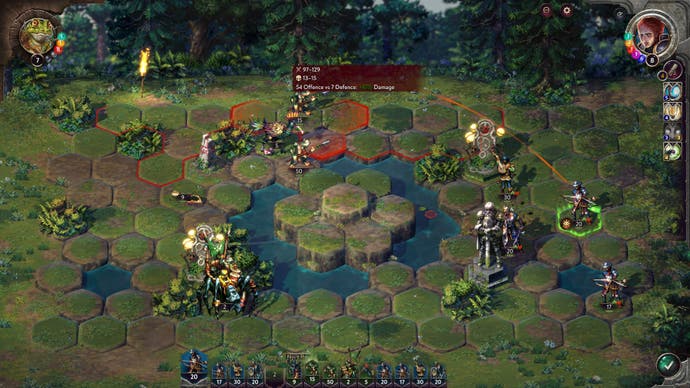

For the most part, though, missions are largely fast-moving and full of nooks and crannies to explore. Much like the Heroes of Might and Magic games that it’s attempting to modernise, Songs of Conquest is a game of two halves. For the most part, you’ll be roaming the map in top-down fashion and hopping between its plentiful supply of glinting curios, snaffling up loose bundles of resources and laying claim to mines, farms and EXP or stat-boosting monuments like a battle-ready magpie. You’ll need as many of these as you can get if you’re going to stand a chance against the many other Silkspool-level adversaries you’ll meet in each campaign, so following these shimmering breadcrumb trails always ensures your turn-based exploration (limited by your Wielder’s movement range) has a sense of drive and purpose.
As part of your proactive approach to exploration, you’ll also eventually start claiming entire settlements for yourself, letting you indulge in some light city-building that will help lay the foundations for the battles ahead. These towns can be managed and upgraded regardless of whether there’s a Wielder residing within its walls, but you’ll need to think carefully about how best to use them. Each settlement only gives you a limited number of free plots to build on, you see, so you’ll need to strike a balance between buildings that give you the pick of the litter when it comes to training specific unit types, and those that will accrue the necessary resources you’ll need to draft them in the first place. There are never enough plots to unlock everything either, and when you’ve got multiple settlements of all shapes and sizes spread across the map, weighing up each piece of this mission-wide tactical puzzle can feel just as meaty and satisfying as building up your base in XCOM – though at least here you also have the option of selling off buildings you don’t need any more, to hopefully make room for ones that are more advantageous.
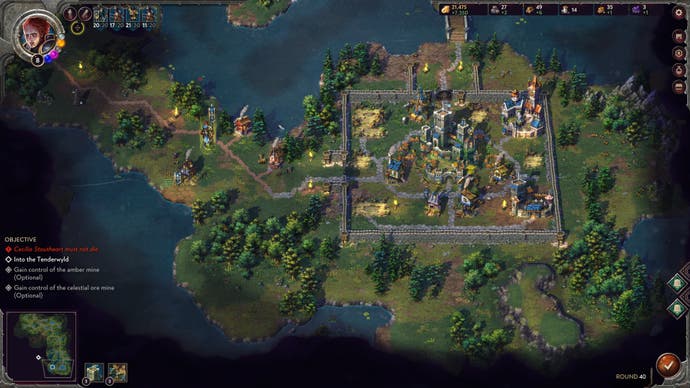
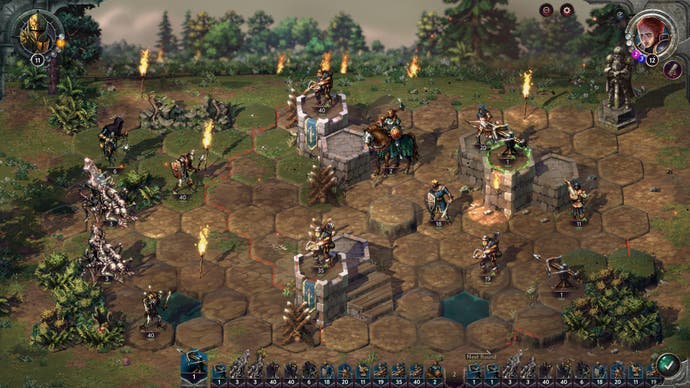

Turtling at home won’t win the day, however. With objective markers always pulling you forward into careful and deliberate advancement, there are plenty of reasons to head out into battle. It’s rare indeed that you’ll be aimlessly wandering the map hoping to run into a good scrap, as enemies are both plentiful and often lying deliberately across your path, making violence inevitable. Besides, even when you do find yourself nosing down a dead-end, there’s always something at the end of it that will have made the trip worthwhile. A rare resource mine, perhaps, or a powerful new weapon that will substantially increase your Wielder’s stats. After all, you’re never in a hurry to be anywhere in Songs of Conquest, as there’s no time or round limit to pile on the pressure. So if you spend a few rounds retracing your steps, it’s really no big deal.
This may rob it of some risk-reward pressure, perhaps, but there’s good reason to luxuriate in the details of Songs of Conquest, and not just from a visual perspective. Individual units may not carry over between missions, for example, but your Wielder’s experience level, equipment and stats are all persistent, giving you plenty of incentive to go the extra mile and really rinse these maps for everything their worth. Because I’m not kidding: even on its default ‘Fair’ difficulty setting, you’re going to need every leg up you can get to complete some of its later missions. There are times when Songs of Conquest’s battles can be surprisingly unforgiving – and not through any real fault of your own either.
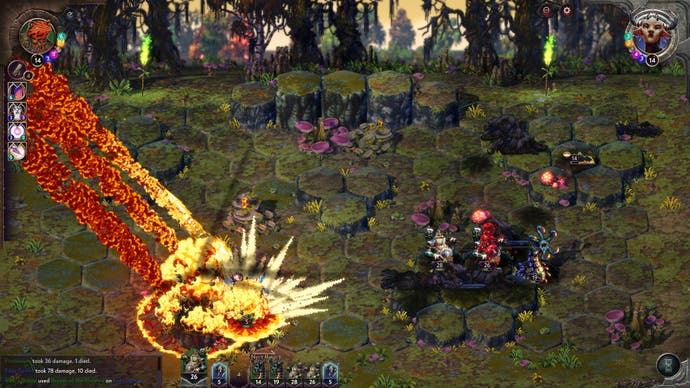

I should stress: these moments where you hit a brick wall are the exception rather than the rule in Songs of Conquest, but every time I slam into one of them, the limitations of its battle system start to become ever more apparent. Indeed, you can regularly feel like you’re doing everything right – you’re tooled up to the nines, have all the best units (and lots of them), and yet you’ll still get minced by enemies with seemingly innocuous threat levels. These levels are flagged up in advance as you get closer to your intended quarry and range from the green and friendly ‘Insignificant’ and ‘Simple’ threats to the ominous red labels of ‘Deadly’ and ‘Futile’. There are nine levels in total, though anything above the yellow-coated and mid-table ‘Risky’ effectively means total and utter annihilation from my experience. The only real difference separating out its top four threat levels is how quickly you’re ground into the dirt – raising the question of why they exist as four separate levels at all.
Most of the time, you can avoid these stationary threats until you’re a bit more powerful, but when an enemy Wielder catches up to you (or assaults one of your towns with very few defences), it’s a different story. If a unit initiates battle with you, there’s no backing out or withdrawing, so you’re forced into battle whether you like it or not. To save yourself the humiliation of a drawn-out defeat, you can simply select ‘Quick Battle’ before you kick things off, and let the game work out the result for you (and if you’re not happy with the outcome or your projected losses, you can then choose to fight the battle manually to try and make a better fist of it).


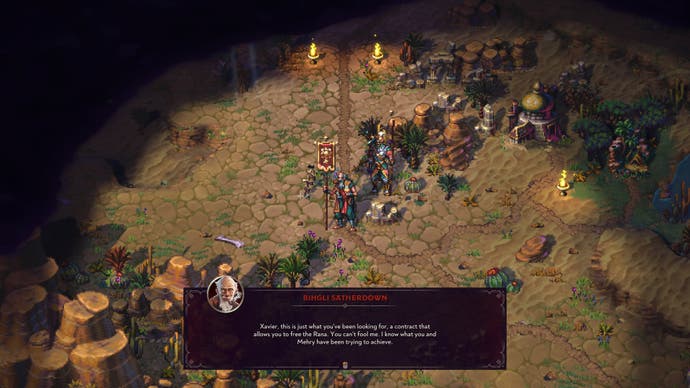
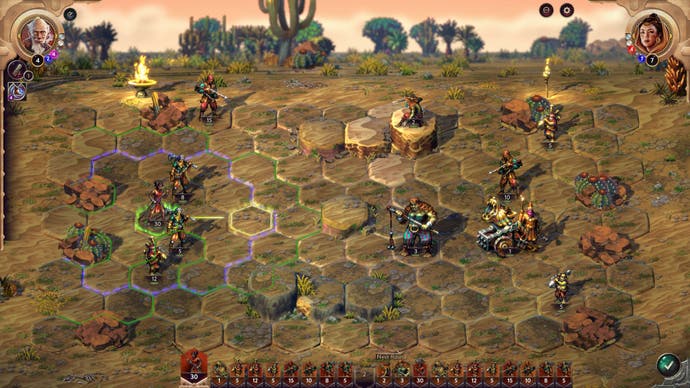
Battles take place on a dedicated grid of hexes, and the terrain is usually pleasingly varied based on your current overworld location. Ponds, statues and hedges create natural choke points, while rolling hills and city ramparts provide height-based terrain advantages, letting ranged troops fire further, and melee troops get the drop on their downhill rivals. Several melee units also have zones of retaliation to consider as well – try and move through it, and they’ll score free hits on you, for example – while ranged units deal more damage when enemies move into their ‘deadly’ zone (which, ironically, is often closer than you’d ideally like). Still, even when you know you’re about to get whomped, every battle is still a feast for the eyes. Every single unit looks and feels like they pack real punch, and when the camera zooms in nice and slow to capture the final, agonising demise of the losing side, there’s real relish to be found in its visual flourishes. Except when you’re the one who’s died, of course. Then it’s just rubbing more salt in the already open wound.
Thing is, these defeats often won’t be through lack of careful preparation or diligent troop reinforcement, nor will it be because you brought dagger-wielding assassins to a gunfight (most of the time, anyway). Songs of Conquest doesn’t have a rock-paper-scissors-style combat system for its individual unit types, nor are there any elemental weaknesses to exploit with your Wielder’s range of magic spells. Instead, everything boils down to pure, clinical damage numbers, which are based on the number of troops you have in any given tile unit. One of your troops could consist of 40 pikemen, say, or five jumbo cannons – the latter’s max unit size being naturally more limited than more basic units due to their higher base attack, defence and health stats.
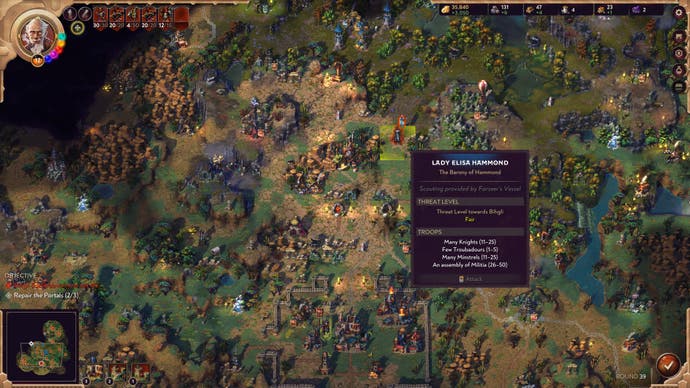
But while damage previews tell you part of the story on how each unit’s attack power is being calculated, there were still frequent moments where I couldn’t work out why my beefier units were being repeatedly mowed down by supposedly less powerful ones. What good is a pack of ten (very expensive) ogres, for example, when they can get instantly skewered by 50 spearmen before they’ve even landed their first punch? The same applied to two of my aforementioned cannon units, too. I had two lots of five of them in a particularly gruelling battle against another formidable Wielder, but they both barely got one hit in before they were utterly demolished by his seven squads of 40 archers. Partly because he was also casting double attack spells on them at the same time, admittedly, but it felt positively insulting that they’d gone down so easily. Those archers repeatedly made swift work of my other units in that fight, too, and each defeat had me hanging my head in my hands, muttering, ‘How? How is he doing this?’ at my PC monitor. This was only meant to have been a ‘Risky’ battle according to the threat level, but the end result felt like anything but.
I did eventually take him down (on what must have been my tenth attempt, and after baiting him to attack me inside a settlement where I had another set of ballistas to help me out), but when you’re throwing everything at the wall and nothing seems to stick, it can sometimes feel like you’re playing a turn-based strategy game with no real strategy to speak of. That’s quite the conundrum when you’re trying to work out where you’re going wrong, as there’s nothing to push back on except sheer brute forcing it. Quantity is regularly better than the quality of warrior, I’ve found, and if your troop numbers start dipping below that of your enemy’s, they quickly lose all tactical relevance, as they can neither deal enough damage to make any real dent on the opposing forces, nor can they defend themselves against incoming attacks – and when even your archer troop ends up being cut in half by goblin bagpipe players, of all things, that’s the kind of indignity that makes you wish there was an instant surrender button.
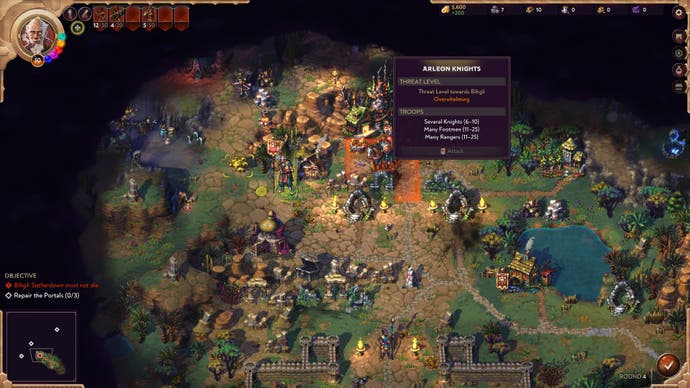
Not all battles are like this, I should add. Keep those threat levels at Risky and below by levelling up your Wielder and noshing on as many map boosters as you can find and there’s still lots of fun to be had here. I had over 20 very happy hours with Songs of Conquest, and the strength of its ambitious storytelling was enough to carry me through these moments of frustration. I genuinely wanted to see what would happen next, even if I knew deep down that the fights, the settlement-building and even the general map exploration was going to be largely the same as what I’d played five hours ago. It’s a bit like tactics comfort food in that sense. It’s mostly predictable, with the same kind of unit types being pumped out of the same kind of faction buildings, just in slightly different shapes and colours, all on the same kind of maps and battlefield terrain. Then there’s the occasional hard kernel of un-popped popcorn that gets lobbed in your jaw, but you’re absolutely determined to crunch through it, because no way in heck are you spitting it back out again. Or maybe that’s just me.
Admittedly, I’m not sure I can say the same of its dedicated, puzzle-style ‘Challenge Maps’ – those just seem determined to mince you right from the off – and even its pre-made ‘Conquest Maps’ feel like they might be pitched a little too steeply, especially for those stuck playing against the AI instead of real-life humans. Despite all this, though, I’m still looking forward to jumping into Songs of Conquest’s sizable multiplayer component once my review build ticks over to its general release version, as well as its already extensive mod scene and player-created campaign maps thanks to its two-year stint in early access. Sure, its lack of strategic depth may leave hardened Fire Emblem and Total War heads a little cold, but like old Captain Silkspool, there’s enough heart and shades of goodness here to at least even out the bum notes. It may not be a full-on belter for the ages, but you’ll be at least tapping your toes until the next big genre earworm rolls around.
A copy of Songs of Conquest was provided for review by Coffee Stain Publishing.
